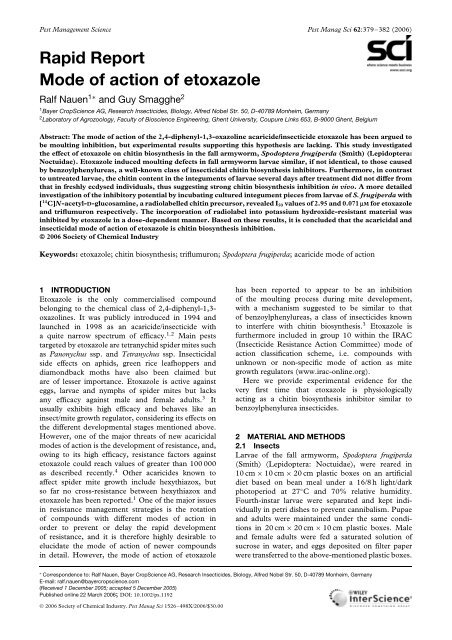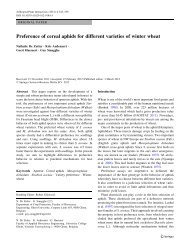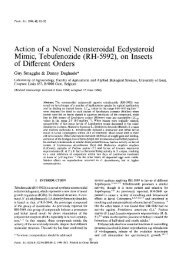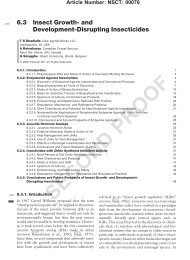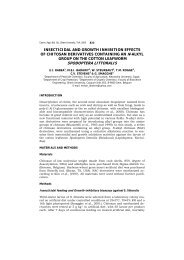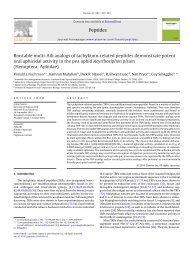Mode of action of etoxazole - ResearchGate
Mode of action of etoxazole - ResearchGate
Mode of action of etoxazole - ResearchGate
You also want an ePaper? Increase the reach of your titles
YUMPU automatically turns print PDFs into web optimized ePapers that Google loves.
Pest Management Science Pest Manag Sci 62:379–382 (2006)<br />
Rapid Report<br />
<strong>Mode</strong> <strong>of</strong> <strong>action</strong> <strong>of</strong> <strong>etoxazole</strong><br />
Ralf Nauen 1∗ and Guy Smagghe 2<br />
1 Bayer CropScience AG, Research Insecticides, Biology, Alfred Nobel Str. 50, D-40789 Monheim, Germany<br />
2 Laboratory <strong>of</strong> Agrozoology, Faculty <strong>of</strong> Bioscience Engineering, Ghent University, Coupure Links 653, B-9000 Ghent, Belgium<br />
Abstract: The mode <strong>of</strong> <strong>action</strong> <strong>of</strong> the 2,4-diphenyl-1,3-oxazoline acaricide/insecticide <strong>etoxazole</strong> has been argued to<br />
be moulting inhibition, but experimental results supporting this hypothesis are lacking. This study investigated<br />
the effect <strong>of</strong> <strong>etoxazole</strong> on chitin biosynthesis in the fall armyworm, Spodoptera frugiperda (Smith) (Lepidoptera:<br />
Noctuidae). Etoxazole induced moulting defects in fall armyworm larvae similar, if not identical, to those caused<br />
by benzoylphenylureas, a well-known class <strong>of</strong> insecticidal chitin biosynthesis inhibitors. Furthermore, in contrast<br />
to untreated larvae, the chitin content in the integuments <strong>of</strong> larvae several days after treatment did not differ from<br />
that in freshly ecdysed individuals, thus suggesting strong chitin biosynthesis inhibition in vivo. Amoredetailed<br />
investigation <strong>of</strong> the inhibitory potential by incubating cultured integument pieces from larvae <strong>of</strong> S. frugiperda with<br />
[ 14 C]N-acetyl-D-glucosamine, a radiolabelled chitin precursor, revealed I 50 values <strong>of</strong> 2.95 and 0.071 µM for <strong>etoxazole</strong><br />
and triflumuron respectively. The incorporation <strong>of</strong> radiolabel into potassium hydroxide-resistant material was<br />
inhibited by <strong>etoxazole</strong> in a dose-dependent manner. Based on these results, it is concluded that the acaricidal and<br />
insecticidal mode <strong>of</strong> <strong>action</strong> <strong>of</strong> <strong>etoxazole</strong> is chitin biosynthesis inhibition.<br />
© 2006 Society <strong>of</strong> Chemical Industry<br />
Keywords: <strong>etoxazole</strong>; chitin biosynthesis; triflumuron; Spodoptera frugiperda; acaricide mode <strong>of</strong> <strong>action</strong><br />
1 INTRODUCTION<br />
Etoxazole is the only commercialised compound<br />
belonging to the chemical class <strong>of</strong> 2,4-diphenyl-1,3-<br />
oxazolines. It was publicly introduced in 1994 and<br />
launched in 1998 as an acaricide/insecticide with<br />
a quite narrow spectrum <strong>of</strong> efficacy. 1,2 Main pests<br />
targeted by <strong>etoxazole</strong> are tetranychid spider mites such<br />
as Panonychus ssp. and Tetranychus ssp. Insecticidal<br />
side effects on aphids, green rice leafhoppers and<br />
diamondback moths have also been claimed but<br />
are <strong>of</strong> lesser importance. Etoxazole is active against<br />
eggs, larvae and nymphs <strong>of</strong> spider mites but lacks<br />
any efficacy against male and female adults. 3 It<br />
usually exhibits high efficacy and behaves like an<br />
insect/mite growth regulator, considering its effects on<br />
the different developmental stages mentioned above.<br />
However, one <strong>of</strong> the major threats <strong>of</strong> new acaricidal<br />
modes <strong>of</strong> <strong>action</strong> is the development <strong>of</strong> resistance, and,<br />
owing to its high efficacy, resistance factors against<br />
<strong>etoxazole</strong> could reach values <strong>of</strong> greater than 100 000<br />
as described recently. 4 Other acaricides known to<br />
affect spider mite growth include hexythiazox, but<br />
so far no cross-resistance between hexythiazox and<br />
<strong>etoxazole</strong> has been reported. 1 One <strong>of</strong> the major issues<br />
in resistance management strategies is the rotation<br />
<strong>of</strong> compounds with different modes <strong>of</strong> <strong>action</strong> in<br />
order to prevent or delay the rapid development<br />
<strong>of</strong> resistance, and it is therefore highly desirable to<br />
elucidate the mode <strong>of</strong> <strong>action</strong> <strong>of</strong> newer compounds<br />
in detail. However, the mode <strong>of</strong> <strong>action</strong> <strong>of</strong> <strong>etoxazole</strong><br />
has been reported to appear to be an inhibition<br />
<strong>of</strong> the moulting process during mite development,<br />
with a mechanism suggested to be similar to that<br />
<strong>of</strong> benzoylphenylureas, a class <strong>of</strong> insecticides known<br />
to interfere with chitin biosynthesis. 3 Etoxazole is<br />
furthermore included in group 10 within the IRAC<br />
(Insecticide Resistance Action Committee) mode <strong>of</strong><br />
<strong>action</strong> classification scheme, i.e. compounds with<br />
unknown or non-specific mode <strong>of</strong> <strong>action</strong> as mite<br />
growth regulators (www.irac-online.org).<br />
Here we provide experimental evidence for the<br />
very first time that <strong>etoxazole</strong> is physiologically<br />
acting as a chitin biosynthesis inhibitor similar to<br />
benzoylphenylurea insecticides.<br />
2 MATERIAL AND METHODS<br />
2.1 Insects<br />
Larvae <strong>of</strong> the fall armyworm, Spodoptera frugiperda<br />
(Smith) (Lepidoptera: Noctuidae), were reared in<br />
10 cm × 10 cm × 20 cm plastic boxes on an artificial<br />
diet based on bean meal under a 16/8 h light/dark<br />
photoperiod at 27 ◦ C and 70% relative humidity.<br />
Fourth-instar larvae were separated and kept individually<br />
in petri dishes to prevent cannibalism. Pupae<br />
and adults were maintained under the same conditions<br />
in 20 cm × 20 cm × 10 cm plastic boxes. Male<br />
and female adults were fed a saturated solution <strong>of</strong><br />
sucrose in water, and eggs deposited on filter paper<br />
were transferred to the above-mentioned plastic boxes.<br />
∗ Correspondence to: Ralf Nauen, Bayer CropScience AG, Research Insecticides, Biology, Alfred Nobel Str. 50, D-40789 Monheim, Germany<br />
E-mail: ralf.nauen@bayercropscience.com<br />
(Received 1 December 2005; accepted 5 December 2005)<br />
Published online 22 March 2006; DOI: 10.1002/ps.1192<br />
© 2006 Society <strong>of</strong> Chemical Industry. Pest Manag Sci 1526–498X/2006/$30.00
R Nauen, G Smagghe<br />
2.2 Insecticides and chemicals<br />
The <strong>etoxazole</strong> and triflumuron used were <strong>of</strong> technical<br />
grade with purities <strong>of</strong> >98% and were obtained<br />
in-house. N-Acetyl-D-[1- 14 C]glucosamine (GluNAc)<br />
with a specific activity <strong>of</strong> 2.17 GBq mmol −1 was<br />
purchased from Amersham BioSciences (Piscataway,<br />
NJ, USA). All other chemicals and solvents were <strong>of</strong><br />
analytical grade and obtained from Sigma (Heidelberg,<br />
Germany) or Merck (Darmstadt, Germany).<br />
2.3 Gravimetric ex vivo determination <strong>of</strong> chitin<br />
deposition in larvae <strong>of</strong> Spodoptera frugiperda<br />
exposed to insecticide-treated leaves<br />
Stock solutions <strong>of</strong> insecticides (1000 mg litre −1 )were<br />
prepared in aqueous Triton X-100 solution (0.2 g<br />
litre −1 ) and diluted accordingly. Circular leaf discs<br />
(44 mm in diameter) cut from true leaves <strong>of</strong> 3-weekold<br />
cabbage plants, Brassica olearacea L., were dipped<br />
for 3 s in insecticidal solutions and transferred to petri<br />
dishes containing a filter paper disc. Subsequently a<br />
single freshly ecdysed sixth-instar larva <strong>of</strong> S. frugiperda<br />
(165–190 mg) was transferred to each leaf disc. Four<br />
freshly ecdysed sixth-instar larvae were directly frozen<br />
at −80 ◦ C and served as 0 h controls. Larvae were<br />
weighed and fed daily with fresh leaf discs (either<br />
treated or untreated), and after 3 days at least three<br />
groups <strong>of</strong> four larvae per test concentration (including<br />
untreated controls) were assessed for symptoms <strong>of</strong><br />
poisoning and frozen at −80 ◦ C. After thawing, larvae<br />
were dissected and integuments free <strong>of</strong> adhering tissue<br />
(4–12 replicates per concentration) were dried for<br />
2 h at 110 ◦ C. The integuments were weighed and<br />
subsequently treated individually with boiling aqueous<br />
potassium hydroxide (2.5 M,2ml)for2h.Afterwards,<br />
integuments were washed with deionised water (2 ml),<br />
hydrochloric acid (0.5 M, 2 ml) and ethanol (2 ml).<br />
The remaining residue (chitin) was dried for 2 h at<br />
100 ◦ C and weighed. The experiment was repeated at<br />
least two times.<br />
Examination for symptoms <strong>of</strong> poisoning was<br />
conducted with fifth-instar larvae using the same<br />
bioassay, except that larvae were not analysed for<br />
integumental chitin content.<br />
2.4 Inhibition <strong>of</strong> incorporation <strong>of</strong><br />
[ 14 C]N-acetyl-D-glucosamine into cultured<br />
integuments <strong>of</strong> Spodoptera frugiperda<br />
Early sixth-instar larvae <strong>of</strong> S. frugiperda were selected<br />
and used for the preparation <strong>of</strong> integument fragments.<br />
Procedures were basically the same as described<br />
by Nakagawa et al. 5 After surface sterilisation <strong>of</strong><br />
larvae with 75% ethanol for 15 min, six integument<br />
fragments <strong>of</strong> about 20 mm 2 were dissected aseptically<br />
and incubated first at 27 ◦ C in 1 ml <strong>of</strong> sterile Grace’s<br />
medium containing 2.2 µM 20-hydroxyecdysone (20E)<br />
but not antibiotics or Bovine serum albumine (BSA).<br />
After 24 h culture the fragments were transferred to<br />
another sterile culture well containing 1 ml <strong>of</strong> Grace’s<br />
medium with 0.2 nmol <strong>of</strong> 14 C-GluNAc but not<br />
containing 20E. These conditions were chosen based<br />
on earlier experiments. 5 To test the effects <strong>of</strong> <strong>etoxazole</strong><br />
and triflumuron, 1 µl aliquots <strong>of</strong> solutions <strong>of</strong> each<br />
compound in dimethyl sulfoxide (DMSO) were added<br />
to the culture wells to give a final concentration range<br />
from 10 −10 to 10 −4 M. The integument fragments were<br />
further incubated in the medium at 27 ◦ Cfor72h.<br />
After incubation the culture medium was removed<br />
from the well and the pieces <strong>of</strong> integument were<br />
washed with deionised water (3 × 0.5ml).Tomeasure<br />
the 14 C activity in the cultured tissues, integument<br />
pieces were treated with an alkaline solution, washed<br />
three times with distilled water and treated overnight<br />
with tissue solubiliser in 20 ml glass liquid scintillation<br />
vials. The amount <strong>of</strong> radiolabel was measured with<br />
Ultima Gold cocktail (PerkinElmer LifeSciences,<br />
Wellesley, MA) in a liquid scintillation counter as<br />
described elsewhere. 6<br />
Based on the dose–response curve, the activity<br />
was expressed as pIC 50 , the negative decadic<br />
logarithm <strong>of</strong> the mean concentration causing 50%<br />
inhibition <strong>of</strong> the incorporation <strong>of</strong> 14 C-GluNAc into<br />
the integument parts, using sigmoidal curve fitting<br />
<strong>of</strong> GraphPad Prism s<strong>of</strong>tware (Statcon, Witzenhausen,<br />
Germany). Data are results <strong>of</strong> two repeat<br />
measurements, and for each compound seven concentrations<br />
were tested (n = 14). The goodness <strong>of</strong><br />
fit was expressed as R 2 . The 0% effect (highest<br />
amount <strong>of</strong> incorporated radiolabel without inhibitor)<br />
was 1622 dpm; the 100% effect (lowest amount <strong>of</strong><br />
incorporated radiolabel with 10 −4 M triflumuron) was<br />
402 dpm.<br />
3 RESULTS AND DISCUSSION<br />
3.1 Effects <strong>of</strong> <strong>etoxazole</strong> on Spodoptera<br />
frugiperda larvae<br />
Potency-wise, <strong>etoxazole</strong> is a strong acaricide and<br />
much less effective against fall armyworm larvae<br />
than benzoylphenylureas such as triflumuron, which<br />
has no acaricidal activity. However, physiological<br />
and biochemical mode <strong>of</strong> <strong>action</strong> investigations with<br />
juvenile spider mites are very difficult to conduct.<br />
Therefore we have chosen S. frugiperda as an<br />
appropriate model insect which is readily affected by<br />
<strong>etoxazole</strong>, thus allowing us to study the mode <strong>of</strong> <strong>action</strong><br />
more closely.<br />
Fifth-instar larvae <strong>of</strong> the fall armyworm feeding<br />
on cabbage foliage treated with <strong>etoxazole</strong> responded<br />
with obvious signs <strong>of</strong> moulting defects in a dosedependent<br />
manner after 3 days, i.e. <strong>etoxazole</strong> was<br />
acting slowly like an insect growth regulator. 7 Most<br />
prominent symptoms were a double head capsule due<br />
to the inability to shed the old one, and incomplete<br />
ecdysis with subsequent loss <strong>of</strong> haemolymph<br />
on the interface between the new head capsule and<br />
thethoracicsegments.Thetreatment<strong>of</strong>fallarmyworm<br />
larvae with <strong>etoxazole</strong> resulted in symptoms <strong>of</strong><br />
poisoning similar, if not identical, to those <strong>of</strong> the benzoylphenylurea<br />
insecticide triflumuron (Fig. 1). The<br />
380 Pest Manag Sci 62:379–382 (2006)<br />
DOI: 10.1002/ps
Etoxazole mode <strong>of</strong> <strong>action</strong><br />
Etoxazole<br />
Chitin per larva (mg)<br />
3.0<br />
2.5<br />
2.0<br />
1.5<br />
1.0<br />
0.5<br />
Etoxazole<br />
Triflumuron<br />
Triflumuron<br />
0.0<br />
1000<br />
200<br />
40<br />
8<br />
1.6<br />
0.32<br />
Untreated 3d<br />
Concentration (mg litre −1 )<br />
Untreated 0d<br />
Figure 2. Inhibition <strong>of</strong> chitin formation in sixth-instar larvae <strong>of</strong><br />
Spodoptera frugiperda exposedto<strong>etoxazole</strong>andtriflumuronafter<br />
foliar application. Three days after application, integuments were<br />
dissected, dried and incubated in 2.5 M KOH and the remaining<br />
residue was gravimetrically analysed. Control larvae (untreated) were<br />
fed with untreated leaves.<br />
Figure 1. Symptoms <strong>of</strong> poisoning by <strong>etoxazole</strong> and triflumuron in<br />
fifth-instar larvae <strong>of</strong> Spodoptera frugiperda. Treated larvae (200 mg<br />
litre −1 ) showed a double head capsule (arrows) and incomplete<br />
ecdysis.<br />
results obtained in this study confirmed hypothetical<br />
considerations that the strong moulting inhibition<br />
effects <strong>of</strong> 2,4-diphenyl-1,3-oxazolines such as <strong>etoxazole</strong><br />
lead to their larvicidal activity in a similar way to<br />
the benzoylphenylureas. 3<br />
The chitin content in integuments <strong>of</strong> sixth-instar<br />
fall armyworm larvae which fed for 3 days on cabbage<br />
leaves treated with concentrations <strong>of</strong> <strong>etoxazole</strong><br />
as low as 40 mg litre −1 did not increase compared<br />
with 3-day-old untreated larvae. Interestingly, the<br />
chitin content <strong>of</strong> <strong>etoxazole</strong>-treated larvae after 3 days<br />
was not significantly different from that <strong>of</strong> freshly<br />
moulted sixth-instar larvae (Fig. 2), thus indicating<br />
its inhibitory potential on chitin biosynthesis. At a<br />
concentration <strong>of</strong> 1.6 mg litre −1 , <strong>etoxazole</strong> no longer<br />
inhibits chitin biosynthesis in vivo, whereas triflumuron<br />
– originally designed to control lepidopteran<br />
larvae – is still fully effective. The inhibition <strong>of</strong> chitin<br />
biosynthesis with both compounds is clearly correlated<br />
with larval mortality (data not shown).<br />
3.2 Inhibition <strong>of</strong> incorporation <strong>of</strong><br />
[ 14 C]N-acetylglucosamine (GluNAc) into cultured<br />
integuments <strong>of</strong> Spodoptera frugiperda<br />
The dose–response relationships <strong>of</strong> <strong>etoxazole</strong> and triflumuron<br />
to the inhibition <strong>of</strong> GluNAc incorporation<br />
into pieces <strong>of</strong> integument <strong>of</strong> S. frugiperda are shown in<br />
Fig. 3. Concentrations <strong>of</strong> ≤10 −7 M <strong>of</strong> <strong>etoxazole</strong> were<br />
not inhibitory, but, at the highest concentration tested<br />
Incorporation <strong>of</strong> GluNAc (dpm)<br />
1750<br />
1500<br />
1250<br />
1000<br />
750<br />
500<br />
250<br />
0<br />
Etoxazole<br />
Triflumuron<br />
10 −11 10 −10 10 −9 10 −8 10 −7 10 −6 10 −5 10 −4 10 −3<br />
Log concentration (M)<br />
Figure 3. Dose–response curves for <strong>etoxazole</strong> and triflumuron on the<br />
incorporation <strong>of</strong> GluNAc into pieces <strong>of</strong> the integument <strong>of</strong> Spodoptera<br />
frugiperda. Curves are fitted based on two replicates per<br />
concentration for each compound tested.<br />
(10 −4 M), its incorporation inhibition was similar to<br />
that <strong>of</strong> the reference compound triflumuron. This<br />
confirms the potency <strong>of</strong> <strong>etoxazole</strong> to inhibit chitin<br />
biosynthesis by interfering with the incorporation <strong>of</strong><br />
GluNAc into the integument, i.e. as described for<br />
benzoylphenylureas. 5 However, based on pIC 50 values,<br />
<strong>etoxazole</strong> (10 −5.53 M,2.95 µM) is about 40 times<br />
less potent than triflumuron (10 −7.15 M, 70.8 nM) in<br />
inhibiting 50% <strong>of</strong> KOH-resistant GluNAc incorporation<br />
(Table 1). Although the inhibitory potential <strong>of</strong><br />
<strong>etoxazole</strong> is 40-fold less than that <strong>of</strong> triflumuron, it is<br />
still rather specific in its effect, considering the pIC 50<br />
value in the lower micromolar range. Furthermore,<br />
<strong>etoxazole</strong> has been developed as an acaricide with only<br />
insecticidal side effects such as described for aphids<br />
and diamondback moth larvae. 3 The inhibitory potential<br />
<strong>of</strong> triflumuron for the incorporation <strong>of</strong> GluNAc<br />
into isolated pieces <strong>of</strong> fall armyworm integuments<br />
Pest Manag Sci 62:379–382 (2006) 381<br />
DOI: 10.1002/ps
R Nauen, G Smagghe<br />
Table 1. Effect <strong>of</strong> <strong>etoxazole</strong> and triflumuron on the net amount <strong>of</strong><br />
KOH-resistant 14 C-GluNAc incorporated into the integument <strong>of</strong><br />
Spodoptera frugiperda. DataaregivenaspIC 50 (±standard error) and<br />
the 95% fiducial limits after sigmoidal curve fitting <strong>of</strong> the<br />
dose–response curves from Fig. 1. The goodness <strong>of</strong> fit is given as R 2<br />
Compound pIC 50 (±SE) 95% fiducial limits R 2<br />
Etoxazole 5.53 (±0.17) 5.15–5.90 0.90<br />
Triflumuron 7.15 (±0.10) 6.93–7.36 0.98<br />
is similar to that described for diflubenzuron on Chilo<br />
suppressalis Walker (20 nM), thus indicating the validity<br />
<strong>of</strong> the chosen assay format with S. frugiperda integuments.<br />
Thus from our experimental results we conclude<br />
that <strong>etoxazole</strong> is an acaricidal (and insecticidal) chitin<br />
biosynthesis inhibitor with a mode <strong>of</strong> <strong>action</strong> similar<br />
to that <strong>of</strong> benzoylphenylureas, i.e. inhibiting the<br />
incorporation <strong>of</strong> the radiolabelled chitin precursor<br />
[ 14 C]GluNAc into the integuments <strong>of</strong> pest invertebrates<br />
affected by this compound.<br />
REFERENCES<br />
1 Ishida T, Suzuki J, Tsukidate Y and Mori Y, YI-5301, a novel<br />
oxazoline acaricide. Proc Brighton Crop Protect Conf – Pests Dis,<br />
BCPC, Farnham, Surrey, pp. 37–44 (1994).<br />
2 Dekeyser M, Acaricide mode <strong>of</strong> <strong>action</strong>. Pest Manag Sci<br />
61:103–110 (2005).<br />
3 SuzukiJ,IshidaT,KikuchiY,ItoY,MorikawaC,TsukidateY,<br />
et al., Synthesis and activity <strong>of</strong> novel acaricidal/insecticidal<br />
2,4-diphenyl-1,3-oxazolines. J Pestic Sci 27:1–8 (2002).<br />
4 Uesugi R, Goka K and Osakabe MH, Genetic basis <strong>of</strong> resistance<br />
to chlorfenapyr and <strong>etoxazole</strong> in the two-spotted spider mite<br />
(Acari: Tetranychidae). J Econ Entomol 95:1267–1274 (2002).<br />
5 Nakagawa Y, Matsutani M, Kurihara N, Nishimura K and<br />
Fujita T, Inhibition <strong>of</strong> N-acetylglucosamine incorporation into<br />
the cultured integument <strong>of</strong> Chilo suppressalis by diflubenzuron.<br />
Pestic Biochem Physiol 42:242–247 (1992).<br />
6 Smagghe G, Carton B, Decombel L and Tirry L, Significance <strong>of</strong><br />
absorption, oxidation and binding to toxicity <strong>of</strong> four ecdysone<br />
agonists in multiresistant cotton leafworm. Arch Insect Biochem<br />
Physiol 46:127–139 (2001).<br />
7 Retnakaran A, Granett J and Ennis T, Insect growth regulators, in<br />
Comprehensive Insect Physiology, Biochemistry and Pharmacology,<br />
Vol. 12, ed. by Kerkut GA and Gilbert LI. Pergamon, Oxford,<br />
pp. 529–602 (1985).<br />
382 Pest Manag Sci 62:379–382 (2006)<br />
DOI: 10.1002/ps


